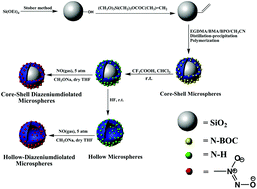Silica/polymer microspheres and hollow polymer microspheres as scaffolds for nitric oxide release in PBS buffer and bovine serum†
Abstract
This work reports the design, preparation and characterization of functional polymer microspheres as a reservoir for nitric oxide (NO)-release. Silica/polymer core–shell microspheres and the corresponding hollow functional polymer microspheres with secondary amino groups were converted to N-diazeniumdiolate as scaffolds for nitrogen oxide (NO) release. The silica/polymer core–shell microspheres were prepared by a multi-step procedure, which involves the synthesis of functional 2-(ethyl(boc)amino)ethyl methacrylate (bocAmEMA) monomers with boc-protected secondary amine sites, distillation precipitation polymerization of ethyleneglycol dimethacrylate and boc-protected co-monomers with the presence of 3-(methacryloxy)propyltrimethoxysilane (MPS)-modified silica nanoparticles as seeds, de-protection of the amino sites, and subsequent reaction between the secondary amino and NO under high pressure (5.0 atm) in the presence of sodium methoxide. The corresponding hollow polymer microspheres were prepared via the selective removal of the silica core from the silica/polymer core–shell microspheres with a hydrofluoride (HF) aqueous solution and the subsequent conversion to N-diazeniumdiolate NO donors via exposure to a high pressure of NO (5.0 atm) under basic conditions. The hollow microspheres with secondary amino groups exhibited a high storage capacity for NO (up to 5.5 μmol NO/mg), greatly increasing that of NO from the corresponding silica/polymer core–shell donors (3.6 μmol NO/mg). Both the silica/polymer and hollow polymer scaffolds are shown to release NO for extended periods of time with an ‘apparent’ t1/2 value of 35 min (silica/polymer scaffolds; PBS buffer), 10 min (hollow polymer scaffolds; PBS buffer), 19 min (hollow polymer scaffolds; bovine serum), and release durations of 24 h via the proton initiated diazeniumdiolate decomposition to give off NO spontaneously under physiological conditions.


 Please wait while we load your content...
Please wait while we load your content...